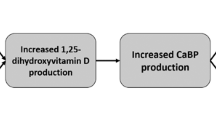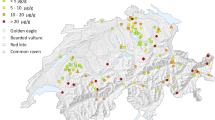A study of wood ducks (Aix sponsa) was conducted along the Coeur d'Alene River system in northern Idaho in 1986 and 1987. Most of this area has been subjected to severe contamination from lead and other metals from mining and smelting since the 1880s. In 1986, a preliminary study of wood duck nesting was conducted in the contaminated area; incubating hens captured in nest boxes were bled and weighed. Blood samples were used to determine lead and cadmium concentrations and physiological characteristics. In 1987, an intensive study of wood ducks involved trapping and monitoring nest boxes in the contaminated area. Blood and tissue samples were also taken from wood ducks from a reference area without known contamination from metals. Lead levels in blood and tissues of most wood ducks from the contaminated area frequently exceeded those considered hazardous to birds; maximum levels (wet weight) of lead were 8 μg g−1 in blood and 14 μg g−1 in liver. Changes in physiological characteristics constituted the only evidence of potentially adverse effects from lead. In the contaminated area, nesting success (55% unadjusted, 35% Mayfield estimate) was less than in other areas where predation was low and nest boxes were used; but lead concentrations and physiological characteristics of blood were similar in successful and unsuccessful hens.
Values of ALAD, hemoglobin, and body mass were negatively correlated with blood concentrations of lead, whereas protoporphyrin was positively correlated with lead levels in the blood. Some of the protoporphyrin values (1,091 μg dl−1 in a male and 756 μg dl−1 in a female) equalled those associated with lead toxicosis in experimental birds. ALAD activity was low in most birds from the contaminated area; values of 0 were obtained from 11 birds. Lead levels in blood, ALAD, protoporphyrin, and hemoglobin were significantly different between birds from the contaminated and reference areas. Concentrations of lead in ingesta of wood ducks ranged from 0.9 to 610 μg g−1 in the contaminated area and 0.2 to 0.6 μg g−1 in the reference area. Levels of cadmium in kidneys of wood ducks ranged from 1μg g−1 to 20 μg g−1 in the contaminated area and from only to 0.1 μg g−1 to 1 μg g−1 in the reference area. Cadmium concentrations were less than known effect levels.
Similar content being viewed by others
References
Anderson, W.L. and Havera, S.P. (1985) Blood lead, protoporphyrin, and ingested shot for detecting lead poisoning in waterfowl. Wildlife Soc. Bull. 13, 26–31.
Anderson, W.L., Havera, S.P. and Montgomery, R.A. (1987) Incidence of ingested shot in waterfowl in the Mississippi Flyway, 1977–1979. Wildlife Soc. Bull. 15, 181–8.
Bart, J. and Robson, D.S. (1982) Estimating survivorship when the subjects are visited periodically. Ecology 63, 1078–90.
Bellrose, F.C. (1959) Lead poisoning as a mortality factor in waterfowl populations. Illinois Nat. Hist. Surv. Bull. 27, 235–88.
Bellrose, F.C. (1976) Ducks, Geese and Swans of North America, 2nd Edn. Harrisburg, PA: Stackpole Books.
Bellrose, F.C., Johnson, K.L. and Meyers, T.U. (1964) Relative value of natural cavities and nesting houses for wood ducks. J. Wildlife Manage. 28, 661–76.
Blus, L.J., Henny, C.J., Hoffman, D.J. and Grove, R.A. (1991) Lead toxicosis in tundra swans near a mining and smelting complex in northern Idaho. Arch. Environ. Contam. Toxicol. 21, 549–55.
Burch, H.B. and Siegel, A.L. (1971) Improved method for measurement of delta-aminolevulinic acid dehydratase activity of human erythrocytes. Clin. Chem. 17, 1038–41.
Burrows, G.E., Sharp, J.W. and Root, R.G. (1981) A survey of blood lead concentrations in horses in the north Idaho lead/silver belt area. Vet. Human Toxicol. 23, 328–30.
Chupp, N.R. and Dalke, P.D. (1964) Waterfowl mortality in Coeur d'Alene River Valley, Idaho. J. Wildlife Manage. 28, 692–702.
Clawson, R.L., Hartman, G.W. and Fredrickson, L.H. (1979) Dump nesting in a Missouri wood duck population. J. Wildlife Manage. 43, 347–55.
Coburn, D.R., Metzler, D.W. and Triechler, R. (1951) A study of absorption and retention of lead in wild waterfowl in relation to clinical evidence of lead poisoning. J. Wildlife Manage. 15, 186–92.
Cook, R.S. and Trainer, D.O. (1966) Experimental lead poisoning of Canada geese. J. Wildlife Manage. 30, 1–8.
Cottrell, S.D., Prince, H.H. and Padding, P.I. (1990) Nest success, duckling survival, and brood habitat selection of wood ducks in a Tennessee Riverine System. In Fredrickson, L.H. et al., eds. Proc. 1988 North American Wood Duck Symposium, St. Louis, MO, pp. 191–97.
Decker, E. (1959) A 4-year study of wood ducks on a Pennsylvania marsh. J. Wildlife Manage. 23, 310–15.
Di, Giulio, R.T. and Scanlon, P.F. (1984) Sublethal effects of cadmium ingestion on mallard ducks. Arch. Environ. Contam. Toxicol. 13, 765–71.
Drobney, R.D. (1982) Body mass and composition changes and adaptations for breeding in wood ducks. Condor 84, 300–5.
Drobney, R.D. and Fredrickson, L.H. (1979) Food selection by wood ducks in relation to breeding status. J. Wildlife Manage. 43, 109–20.
Drobney, R.D. and Fredrickson, L.H. (1985) Protein acquisition a possible proximate factor limiting clutch size in wood ducks. Wildfowl 36, 122–8.
Ellis, M.M. (1940) Pollution of the Coeur d'Alene River and adjacent waters by mine wastes. US Bureau of Fisheries Special Sci. Rep. No. 1.
Finley, M.T., Dieter, M.P. and Locke, L.N. (1976) δ-Aminolevulinic acid dehydratase: inhibition of ducks dosed with lead shot. Environ. Res. 12, 243–9.
Franson, J.C., Haramis, G.M., Perry, M.C. and Moore, J.F. (1986) Blood protoporphyrin for detecting lead exposure in canvasbacks. Pages 32–37 In Feierabend, J.S. and Russell, A.B. eds. Lead Poisoning in Wild Waterfowl—A Workshop. Washington, DC: National Wildlife Federation.
Grice, D. and Rogers, J.P. (1965) The wood duck in Massachusetts. Massachusetts Div. Fish and Game, Pittman-Robertson Proj. Rep. W-19-R.
Hanson, H.S. (1954) Criteria of age of incubated mallard, wood duck, and bobwhite quail eggs. Auk 71, 167–172.
Henny, C.J., Blus, L.J., Hoffman, D.J., Grove, R.A. and Hatfield, J.S. (1991) Lead accumulation and osprey production near a mining site on the Coeur d'Alene River, Idaho. Arch. Environ. Contam. Toxicol. 21, 415–24.
Hepp, G.R., Kennamer, R.A. and HarveyIV, W.F. (1990) Incubation as a reproductive cost in female wood ducks. Auk 107, 756–64.
Heusmann, H.W. (1972) Survival of wood duck broods from dump nests. J. Wildlife Manage. 36, 620–4.
Hinderberger, E.J., Kaiser, M.L. and Koirtyohann, S.R. (1981) Furnace atomic absorption analysis of biological samples using L'vov platform and matrix modification. Atomic Spectroscopy 2, 1.
Hines, J.E. and Sauer, J.R. (1989) Contrast. A general program for the analysis of several survival rate estimates. US Fish and Wildlife Service. Fish and Wildlife Tech. Rep. No. 24.
Hocutt, G.E. and Dimmick, R.W. (1971) Summer food habits of juvenile wood ducks in east Tennessee. J. Wildlife Manage. 35, 286–92.
Jones, R.E. and Leopold, A.S. (1967) Nesting interference in a dense population of wood ducks. J. Wildlife Manage. 31, 221–8.
Klett, A.T., Duebbert, H.F., Faanes, C.A. and Higgins, K.F. (1986) Techniques for studying nest success of ducks in upland habitats in the prairie pothole region. US Fish Wildlife Service Resource Publ. No. 158.
Krieger, R.I. (1990) Toxicity and bioavailability studies of lead and other elements in the lower Coeur d'Alene River. Idaho BLM Tech. Bull. No. 90-3.
Krynitsky, A.J. (1987) Preparation of biological tissue for determination of arsenic and selenium by graphite furnace atomic absorption spectrometry. Anal. Chem. 59, 1884–6.
Longcore, J.R., Locke, L.N., Bagley, G.L. and Andrews, R. (1974) Significance of lead residues in mallard tissues. US Fish and Wildlife Service. Spec. Sci. Rep. Wildlife No. 182.
Mayack, L.A., Bush, P.B., Fletcher, O.J., Page, R.K. and Fendley, T.T. (1981) Tissue residues of dietary cadmium in wood ducks. Arch. Environ. Contam. Toxicol. 10, 637–45.
Mayfield, H.F. (1961) Nesting success calculated from exposure. Wilson Bull. 73, 255–61.
Mayfield, H.F. (1975) Suggestions for calculating nest success. Wilson Bull. 87, 456–66.
Morse, T.E. and Wight, H.M. (1969) Dump nesting and its effect on production in wood ducks. J. Wildlife Manage. 33, 284–93.
Moser, J.D. (1983) The incidence of shot ingestion in New York waterfowl: Results of a 1977–1982 gizzard collection study. Northeast Fish Wildlife Conf. 40, 110–7.
Pain, D.J. and Rattner, B.A. (1988) Mortality and hematology associated with the ingestion of one number four shot in black ducks, Anas rubripes. Bull. Environ. Contam. Toxicol. 40, 159–64.
Rabe, F.W. and Flaherty, D.C. (1974) The river of green and gold. Idaho Research Foundation, Inc., Natural Resources Series No. 4.
Roscoe, D.E., Nielsen, S.W., Lamola, A.A. and Zuckerman, D. (1979) A simple quantitative erythrocyte protoporphyrin in lead poisoned ducks. J. Wildlife Dis. 15, 127–36.
Sanderson, G.C. and Bellrose, F.C. (1986) A Review of the problem of lead poisoning in waterfowl. Illinois Nat. Hist. Surv. Spec. Publ. No. 41, pp. 1–34.
Sauer, J.R. and Williams, B.K. (1989) Generalized procedures for testing hypotheses about survival or recovery rates. J. Wildlife Manage. 53, 137–42.
Scanlon, P.F., Stotts, V.D., Oderwald, R.G., Dietrick, T.J. and Kendall, R.J. (1980) Lead concentrations in livers of Maryland waterfowl with and without ingested lead shot present in gizzards. Bull. Environ. Contam. Toxicol. 25, 855–60.
Semel, B., Sherman, P.W. and Byers, S.M. (1990) Nest boxes and brood parasitism in wood ducks: A management dilemma. In Fredrickson, L.H. et al., eds. Proc. 1988 North American Wood Duck Symposium, St. Louis, MO pp. 163–70.
Trost, R.E. (1980) Ingested shot in waterfowl harvested on the Upper Mississippi National Wildlife Refuge. J. Wildlife Manage. 37, 90–93.
US Fish and Wildlife Service (1986) Use of lead shot for hunting migratory birds in the United States. Final Environmental Impact Statement. Washington, DC: USFWS. FES 86–16.
Vengris, V.E. and Mare, C.J. (1974) Lead poisoning in chickens and the effect of lead on interferon and antibody production. Can. J. Comp. Med. 38, 328–35.
Weller, M.W. (1956) A simple field candler for waterfowl eggs. J. Wildlife Manage. 20, 111–3.
White, D.H., Finley, M.T. and Ferrell, J.F. (1978) Histopathologic effects of dietary cadmium on kidneys and tissues of mallard ducks. J. Toxicol. Environ. Health 4, 551–8.
Zwank, P.J., Wright, V.L., Shealy, P.M. and Newsom, J.D. (1985) Lead toxicosis in waterfowl on two major wintering areas in Louisiana. Wildlife Soc. Bull. 13, 17–31.
Author information
Authors and Affiliations
Rights and permissions
About this article
Cite this article
Blus, L.J., Henny, C.J., Hoffman, D.J. et al. Accumulation and effects of lead and cadmium on wood ducks near a mining and smelting complex in Idaho. Ecotoxicology 2, 139–154 (1993). https://doi.org/10.1007/BF00119436
Received:
Accepted:
Issue Date:
DOI: https://doi.org/10.1007/BF00119436




